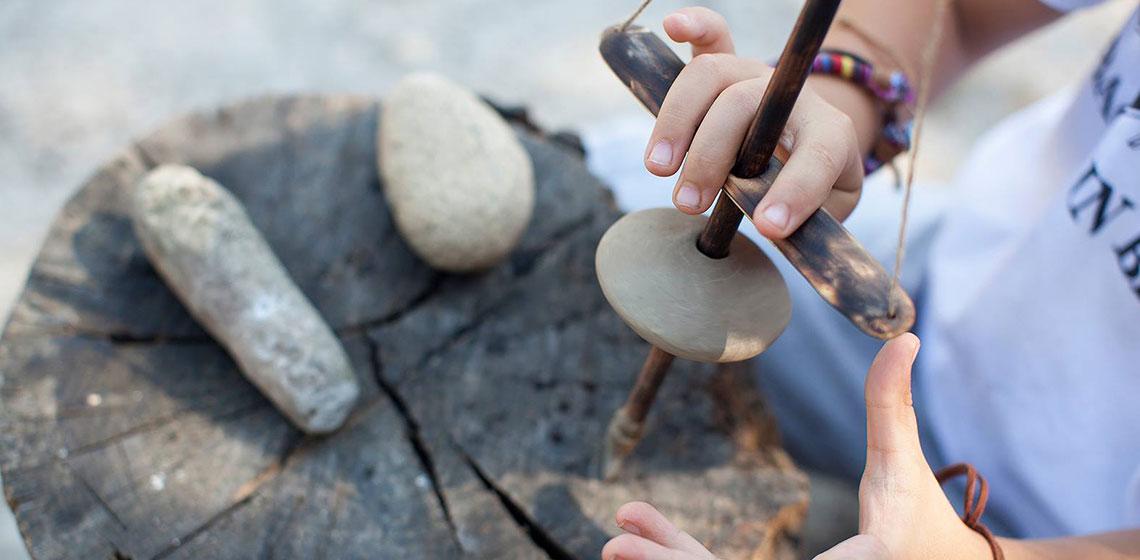Aktopraklık Höyük Açıkhava Müzesi ve Arkeoloji Okulu (TR)

The Aktopraklık Höyük Open-Air Museum and Archaeology School is run by the Istanbul University Department of Prehistory. The foundation of this cultural heritage management project is the archaeological evidence from the excavation conducted at the prehistoric mound of Aktopraklık.
The project, while encompassing all aspects of archaeology, is open to a wider interactivity through traditional ethnographic exhibits and experimental research areas together with the conservation and the presentation of archaeological sites. One of the major goals is to conserve and restore traditional wooden houses with their related ethnographic objects, which were re-erected on the site. Reconstructions of the Chalcolithic and Neolithic architecture discovered in excavations have also been completed. Furthermore, a new method has been developed to preserve and display excavated mud brick architecture from the Early Chalcolithic period, such that visitors can observe the preserved architecture in situ from our newly installed viewing tower. Local inhabitants as well as workers from the highly industrialized area of Bursa are involved in these heritage management practices. Since the site of Aktopraklık is located in the vicinity of Bursa, the fourth most populous city in Turkey and a recreational area in the region, one of our main goals to integrate Aktopraklık into the existing tourism infrastructure.
We aim to catch the attention of these urban tourists and shift their focus towards the surrounding natural environment and rural life, while providing educational information about regional ecology, history, archaeology and traditions. Moreover, we aim to provide sustainable benefits to the local community.
The project history of the Arkeopark began with its conception in 2005. In that year, the walls of the fragile mud brick architecture of the Chalcolithic period were fitted with and completely encapsulated within both waterproof geotextile and protective boards. This serves the dual purpose of both conserving the fragile architecture while also allowing for the architectural plan to be exhibited to visitors without the risk of harm and erosion to the remains. This system has since been implemented for all exposed mud brick architecture. This long-term planning is now demonstrating fruitful results 10 years later: when visitors climb the new viewing tower, completed in 2015, they can observe twenty-five well-preserved, mud brick house plans in situ, and thus better understand the layout and structure of the Chalcolithic settlement as a whole.
In order to respect and display heritage not only from the prehistoric period, but also from the more recent past, documentation of Ottoman period wooden houses in nearby Eskikizielma village, where most site workers reside, began in 2005. These 200-year-old houses were otherwise being left to decay, or being destroyed and replaced with concrete architecture. One of the main objectives of this project was therefore to transfer to future generations the traditional village panorama that may have otherwise vanished completely.
After the architecture was documented and photographed completely, including individual life histories for each building, in 2009, the houses were taken apart piece by piece and, based on detailed documentation work, painstakingly reassembled as a small village on the Aktopraklık site. This project continues, as we hope to bring an inventory of regional traditional architectural history to the site, along with displaying traditional materials like wedding garments, grinding stones, and cooking pots. This serves the purpose of simultaneously exposing visitors to regional heritage, spanning from prehistory to today, and instilling pride in the local residents whose heritage is being displayed.
Also in 2009, reconstructions of the ancient Chalcolithic mud brick houses were begun, both as a practical, experimental demonstration of ancient techniques, and allowing visitors to better understand how the ancients lived. In that same year, mud brick walls for these four houses were built atop the foundation, utilizing the traditional expertise of our Eskikızıelma workers. In subsequent years, additions for the houses included rooves, internal ovens, external ovens, floor furnaces, platforms, courtyards and arbors, and drainage to ensure that winter rains do not prevent visitors from exploring the houses.
Mannequins and imitations of ancient artifacts, such as pottery and leather rugs, were also displayed in these houses in 2015 to give the buildings texture and better demonstrate ancient lifeways. The courtyard of these houses also serves as the perfect setting for experimental archaeology workshops focused on ancient techniques. Similarly, wattle and daub pit houses were reconstructed near the area that they were excavated. In the coming days, glass-covered grave reconstructions will accompany these houses. As silicon molds of some recovered skeletons and associated finds were creating during initial excavation, it is now possible to exactly reconstruct and present the diversity of prehistoric burial traditions to visitors.
Construction and modification accelerated in the last few years with the generous support of the Bursa Metropolitan Municipality. In 2014, construction of a visitor center and visitor pathway began. In Spring 2015, construction of a viewing tower was completed. Its purpose is to allow visitors to observe the excavation area and ancient architecture in context, along with the reconstructions and surrounding area, including the Uluabat Lake panorama in the distance. In summer 2015, an entranceway and parking lot, cafeteria, children’s lab, children’s imitation excavation, and new depots to house finds were all built with support of the Bursa Metropolitan Municipality in advance of the official opening of the Open-Air Museum and Archaeology School on September 11, 2015. The mayor of the Bursa Municipality, a representative of the Ministry of Culture, and excavation director Dr. Necmi Karul made speeches to ring in the official opening. Locals from Akçalar, site laborers from Eskikızıelma, local officials, and interested guests from the region were in attendance. The inaugural children’s workshop was also realized on opening day.
